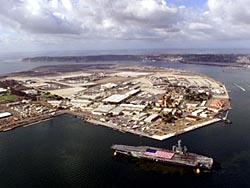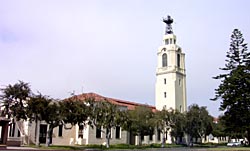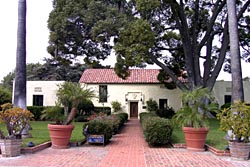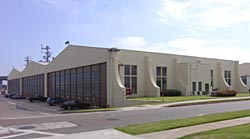
The Naval Air Station, San Diego, Historic District, located on North Island in California, is associated with broad national and regional themes in the history of military aviation, representing the principle administrative and residential core of one of the earliest naval air stations in the United States, and the first on the West Coast. Climatic conditions, and the characteristics of flat terrain, good beaches and protected stretches of water, attracted the aviation pioneer and Wright Brothers' competitor, Glenn H. Curtiss, to North Island in 1910. Through the intervention of a local flying club, the landowner, the Coronado Beach Company, was persuaded to permit Curtiss to use North Island for his Aviation School. In December 1910, the Navy assigned its first pilot, Lt. T.G. Ellyson, to be trained by Curtiss at his school on North Island. The Navy established its first naval aviation unit at Annapolis, Maryland, in September 1911. However, because winters in the Northeast precluded flight operations, North Island was chosen for the aviation unit's winter quarters. In 1912 "Camp Trouble," as it was called, was established on the northeast corner of North Island, a site now encompassed by the Naval Air Station, San Diego, Historic District. Consisting of three airplanes, three pilots, three tents and some mechanics, this group stayed until April, then returned east. The Navy would not return to North Island until 1917.

The Army's Signal Corps Aviation School relocated from its original location at College Park, Maryland, to North Island, San Diego, from November to December 1912. The Army flyers established a tent camp at the north end of North Island, and for about a year, the Signal Corps Aviation School rented airplanes and hangars constructed for the Curtiss school. This was the first Army school to provide flying training for military pilots, and North Island was the school's first permanent location. None of the buildings from this early period, constructed on the north end of the island, are still extant. In July 1917, Congress authorized the President to proceed with the taking of North Island for Army and Navy aviation schools. There was a desperate needed for trained military pilots as the United States had entered World War I earlier in the year. President Woodrow Wilson signed an Executive Order in August 1917 for condemnation of the land, which was still privately owned. The Army turned over the north end of the island to the Navy and relocated to the south end of North Island, the location of the Rockwell Field Historic District. The Navy's first occupancy of North Island occurred on September 8, 1917, but Congress did not authorize the purchase of North Island, for $6,098,333, until July 1919. Construction began on the permanent San Diego facilities in mid-1918. Naval Air Station, San Diego was completed too late to play any substantial role in World War I. After conducting the first-ever carrier takeoffs and landings in the Atlantic, the USS Langley was assigned to Naval Air Station, San Diego, berthing there for the first time in November 1924. This began a continuous use of North Island as the home port for Pacific Fleet carriers, and Naval Air Station, San Diego took on the duties of providing service and training to the personnel of these new components to the Fleet.

Throughout the late 1920s and early 1930s, military pilots worked hard at trying to make the public more aviation-conscious. The Naval Air Station, San Diego continued as an important player in this ongoing effort, due to its proximity to Hollywood, which allowed it to play a unique role in the promotion of air power. Several movies, among them Flying Fleet, The Flying Marine and Hell Divers, were filmed at the air station, with the full cooperation of the Navy. The Navy wanted to add the Army's Rockwell Field to Naval Air Station, San Diego, and tried for many years to acquire it. The effort was finally successful when President Roosevelt was persuaded to issue an Executive Order that required the Army to vacate North Island by 1935, in spite of the Army's struggle to remain there. At the same time dredge spoils were dumped into the tidal flats which increased the area of North Island by some 620 acres. By 1935 North Island was home to all four of the Navy's carriers--the USS Langley, USS Lexington, USS Saratoga and USS Ranger. During the 1930s activities at the air station were of fundamental importance to the development of combat tactics and logistical support systems that became the foundation for the subsequent success of the Pacific carrier war against Japan during World War II.

The principal historic buildings in the Naval Air Station, San Diego, Historic District consist of more than 20 military administrative, residential and operations buildings constructed with stucco-clad walls, red tile roofs and simple California Mission or Mission Revival style design elements. The visual focus of the historic district, and perhaps its most recognized edifice, is the Administrative Building, a two-story building with a monumental, 110-foot-tall central tower. This tower was functionally designed to carry aerological equipment, serving as the air station's pre-radio control tower. Of other aviation interest are the Seaplane Hangars, three buildings that are single-story, rectangular, open bay buildings and the Garage, a simple, one-story, flat-roofed, rectangular building that functioned to service the air station vehicles.
Visit the National Park Service Travel American Aviation to learn more about Aviation related Historic Sites.
Last updated: August 29, 2017
